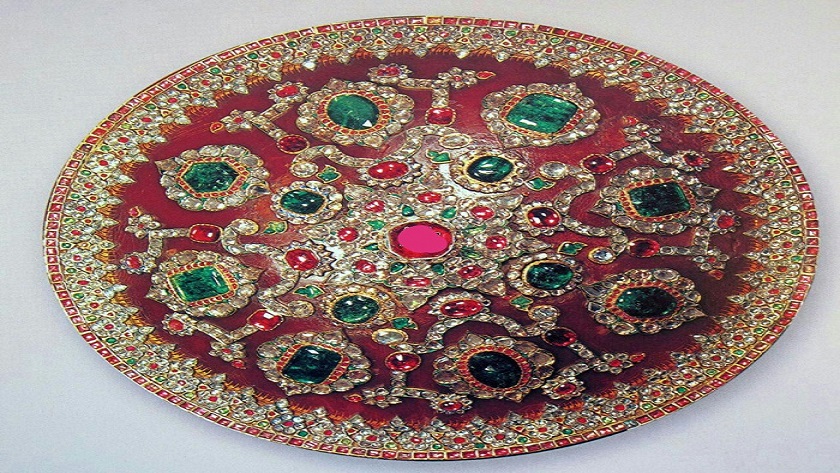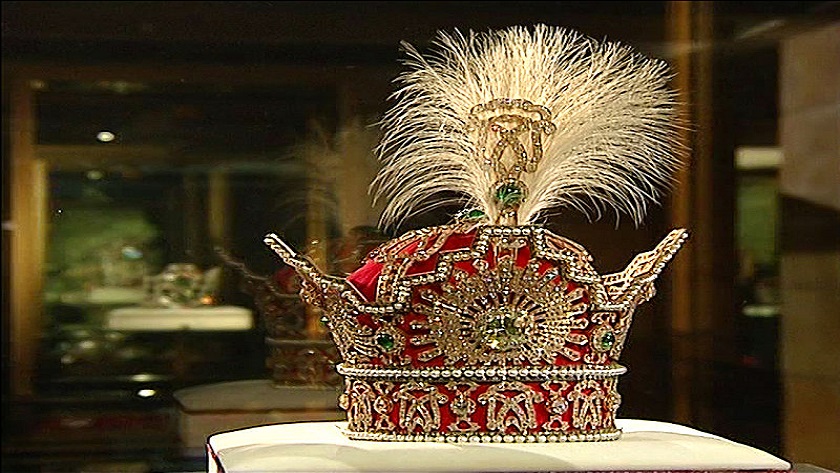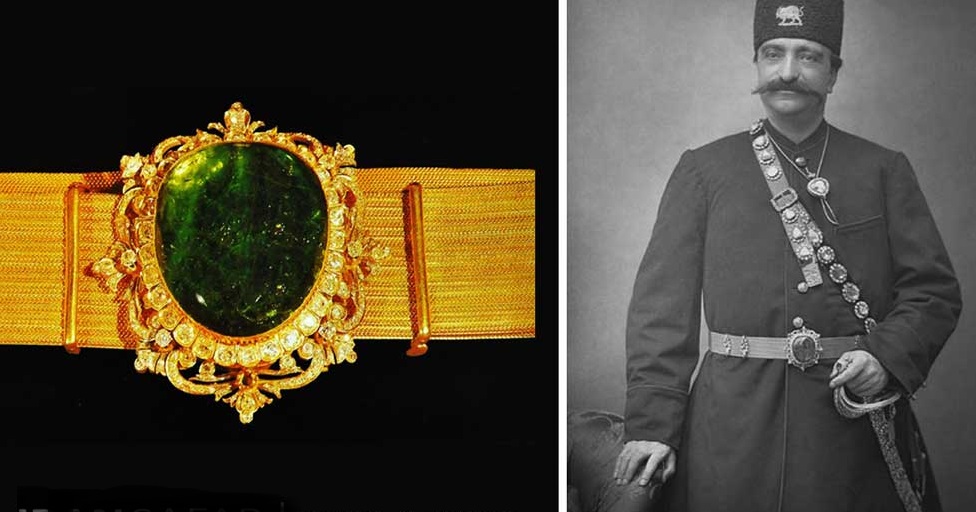Iran Press/ Iran news: A Collection of the most expensive jewels of the world, the incomparable “Treasury of the National Jewels” is collected over centuries. This valuable collection reflects the creativity and taste of Iranian craftsmen and artists during different eras and represents the highly rich cultural heritage of a vast country.
 Iran National Jewelry Museum
Iran National Jewelry Museum
History of Iran National Jewels
The collection of national treasures of Iran developed during the Qajar period (19th century). It was during this period that jewelry design was supported and developed for the first time. Iranian and Armenian designers and jewel makers were invited to the court, and the making and collection of exquisite gifts and the precise classification of government treasury jewelry started. Kiani crown, Naderi throne, Jewel Globe and Peacock Throne (Sun Throne) are among the treasures of this period. Neyshabour turquoise and Persian Gulf pearls were gradually added to the precious collections.
 Iran's National Jewels are of great historical significance
Iran's National Jewels are of great historical significance
These royal jewels and exquisite gems were kept in Golestan Palace during the Qajar period and then in the basement of Marble Palace (Marmar Palace) during the first Pahlavi period. In 1937, during the reign of Reza Shah Pahlavi, the ownership of the Imperial treasury was transferred to the state and after the completion of Iran National Bank (Bank Meli) building, the jewels were placed in the vaults of the National Bank of Iran, where they were used as collateral to strengthen the financial power of the institution and to back the national monetary system.
Related article: Hand-woven carpet and Siraf port jewels of Iranian art, history
Today, the crown jewels of Iran are protected by the Central Bank of the Islamic Republic of Iran and its unique collection exposes many jewels of the Safavid, Afsharid, Qajar and Pahlavi dynasties to the public.
 Iranian national jewels are highly valuable in cultural terms
Iranian national jewels are highly valuable in cultural terms
Iranian Crown Jewels
In terms of artistic value, history and uniqueness, even the best experts and evaluators in the world have not been able to calculate Iran’s national jewelry true or approximate value. It contains some unique gems and jewels that have no equal in the world. However, the value of the collection is not limited to the financial aspect of them. The cultural value of the items that reflect the history, unique designs, creativity, and imagination of the artists is something not to be undermined.
 Peacock throne
Peacock throne
Peacock Throne
Peacock Throne (throne of the sun) was built in 1798 by the order of Fath Ali Shah. This throne is adorned with 26,733 gems, including an extravagant carved sun on the top of the throne studded with precious diamonds. That is why this throne was originally called the throne of the sun, but later became known as the peacock throne (Takht-e Tavoos) on the occasion of Fath Ali Shah’s marriage to a woman called Tavoos Taj al-Dawlah and the throne became known as the Peacock Throne in her honor.
Of course, most Iranians thought that this throne was the same as the Indian peacock throne of the Mughal king Shah-i Jahan but further research showed that this unique work was made by the order of Iranian Qajar king Fath Ali Shah and has nothing to do with the Indian peacock throne.
 Nader Shah’s Shield
Nader Shah’s Shield
Nader Shah’s Shield
One of the special objects of the jewelry treasury is Nader Shah’s shield, which he used in various wars. 46 cm in diameter, this shield is covered with rhino skin and is studded with emeralds, rubies and diamonds. Initially, it had a simple cover; But later, like the sword, it was ornamented by the order of Fath Ali Shah Qajar. In the center of this shield, you will see one of the largest rubies in the world, weighing 225 carats, surrounded by a star of rows of diamonds, rubies and emeralds.
 Daria-i-Noor, weighing 182 carats in pale pink
Daria-i-Noor, weighing 182 carats in pale pink
Darya-i Noor
This diamond may be the first among the national jewels of Iran. This famous diamond and the diamond of Kuh-i Noor, apparently due to the closeness of the name, have always been considered a couple, while in terms of cut and color, they have nothing in common with each other. Both gems were brought to Iran by Nader Shah from his Delhi conquest, but the diamond of Kuh-i Noor was stolen and taken to Afghanistan after Nader’s death. It was later presented to Queen Victoria by the East India Company. The gem is still on the crown of British monarchs.
After Nader Shah’s assassination, the Darya-i Noor diamond passed to his grandson Shahrukh Mirza, and later to Lotfali Khan Zand. When Lotfali Khan was defeated by Qajars, the gem was transferred to the Qajar jewelry treasury and now adorns the crown jewels Treasury. Darya-i Noor weighs 182 carats and its color is pink, which is the rarest color of diamonds.
 Jeweled Globe
Jeweled Globe
Jeweled Globe
Located at the end of the treasury hall, another most valuable treasure of the National Jewelry Museum is the jeweled Globe that fascinates visitors. This globe was made in 1874, by the order of Nasser al-Din Shah, and by a group of Iranian jewelers. The net weight of the gold used in this item is 34 kg and the weight of its jewelry is 3,656 grams. The total number of jewels installed on the globe is 51,366 pieces. The seas and oceans on the globe are represented by emeralds and the lands by rubies, diamonds, and sapphires. Southeast Asia, Iran and the United Kingdom are marked with diamonds, India with rubies and Central and South Africa with sapphires.
 Pahlavi Crown
Pahlavi Crown
Pahlavi Crown
This crown, which was made in the shape of the crown of the Sassanian kings, was used by Reza Shah and Mohammad Reza Pahlavi. Made of gold and silver, this crown is adorned with high quality diamonds, large emeralds, rubies and pearls. The crown that was previously used in the coronations of the Qajar period was the Kiani crown, but Reza Khan Pahlavi did not want to use it in his coronation. Therefore, in 1925, a group of Iranian jewelers, under the supervision of Sirajuddin Javaheri, the famous Caucasian jeweler and jeweler Amir Bukhara, who had emigrated from Russia to Iran, made the crown from selected gems. Inspiration for the new design was drawn from paintings and historical references to crowns used during the Sassanian Empire, which had ruled Persia from 224 to 651 AD.
 Kiani Crown
Kiani Crown
Kiani Crown
The crown of Fath Ali Shah, known as the Kiani crown, is adorned with diamonds, emeralds, rubies and pearls. This crown was made during the reign of Fath Ali Shah and was used by Qajar kings.This crown is the first crown that has been made in this way after the Sassanid Empire.
 Golden belt Nasser has worn by al-Din Shah of Qajar
Golden belt Nasser has worn by al-Din Shah of Qajar
The Golden Belt
The belt is a 119 cm long gold strap with a unique and shining elliptical emerald weighing 176 carats. The emerald adorned with 60 pieces of Brilliant diamonds, and 145 pieces of Flamenco diamonds, gives a stunning shine to the belt. Nasser al-Din Shah of Qajar used the Golden belt in occasion of official ceremonies.
Read More:
Iranian Turquoise; what Iran is known for
Persian Miniature; What Iran is known for
Ashkan Salehian

